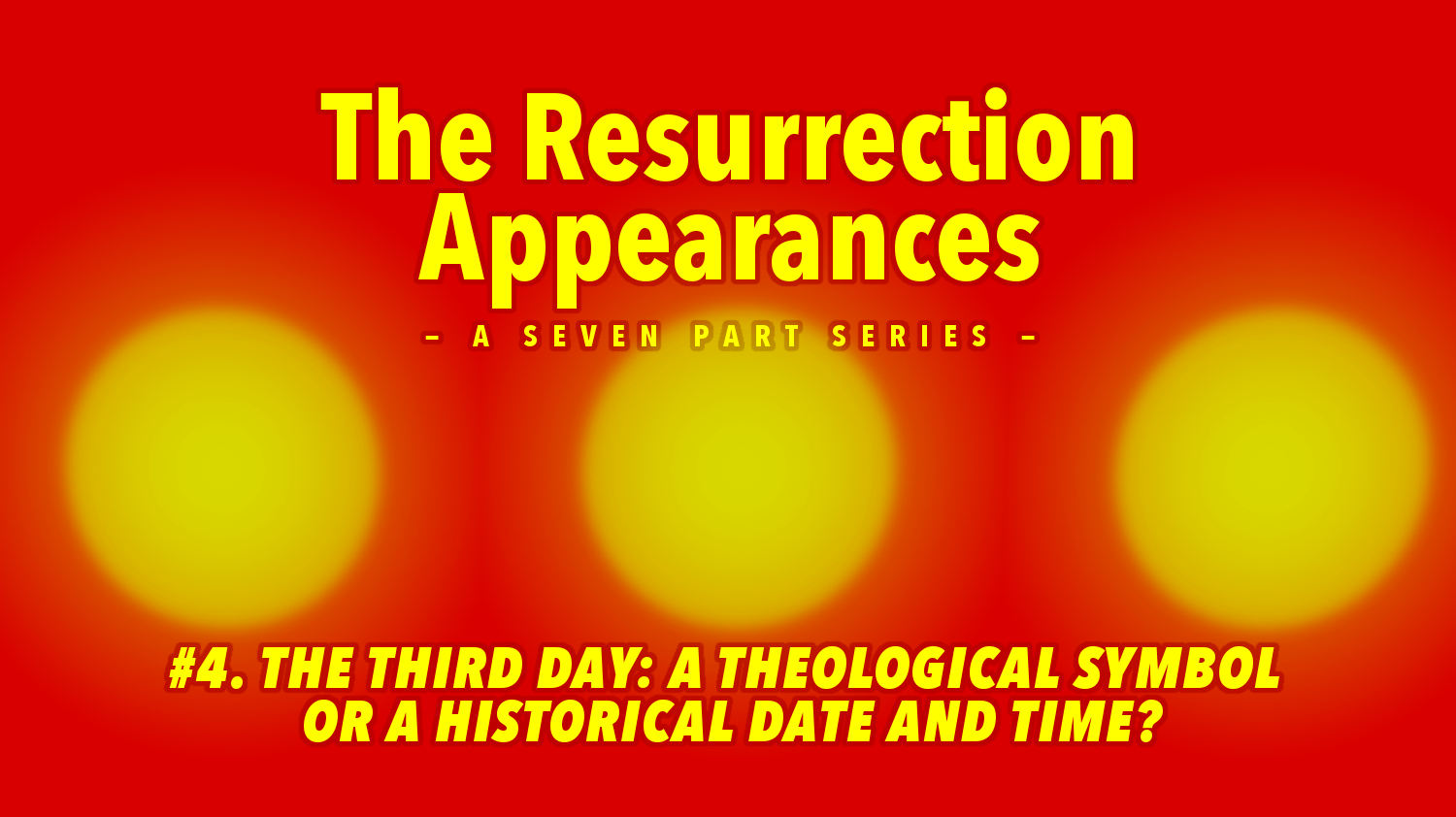
The Resurrection Appearances: A Seven Part Series
Part 4. The Third Day: A Theological Symbol or a Historical Date and Time?
If the resurrection of Jesus Christ was a historical fact, as Wolfhart Pannenberg contends, then there was a specific date and time when the resurrection happened. The New Testament provides two potential times for dating the resurrection of Jesus: the gospels say "the first day of the week" (Mark 16:2) and Paul says "on the third day in accordance with the scriptures" (1 Cor 15:4). In this post, I will discuss whether the day and time of the resurrection of Jesus may be established as a historical fast based on the biblical data.
Paul's "On The Third Day According To The Scriptures"
Pannenberg argues that Paul's account of the resurrection appearances in 1 Corinthians 15:1-8 is the oldest tradition in the New Testament, and predates what is recorded in the Gospels. Paul provides a long list of resurrection appearances, listing people who saw the risen Jesus after the resurrection. Pannenberg and other theologians believe that the order of the list may not be chronological, especially since Paul places Peter at the head of the list, and his own encounter at the end of it. Pannenberg argues that the first three resurrection appearances that mention Peter, the twelve, and the five hundred, are best understood as traditional list that Paul learned from others, and Paul's unique addition of James, all the apostles, and lastly his own experience were his unique additions to the list.
What is significant about Paul's list of resurrection appearances, is his dating of the resurrection "on the third day in accordance with the scriptures" (1 Cor 15:4). Although there were many known resurrection appearances, this phrase at the head of the list indicates that there was a specific date and time when the resurrection happened, and this means that the resurrection appearances cannot be explained as hallucinations or visions without any historical reality.
Paul's phrase "on the third day in accordance with the scriptures" is problematic for dating, because there is no specific known scripture in the Old Testament (and the New Testament hadn't been written yet), that was specifically fulfilled. Pannenberg and most scholars believe that the phrase "third day" may be a reference to Hosea 6:1-2 that has the phrase "after two days he will revive us; on the third day he will raise us up, that we may live before him." (Other theologians suggest that Jonah 2:1 or Esther 4:16; 5:1 [3] are other possible candidates). So the nebulousness of the phrase, indicates a general fulfillment of scriptures, without a specific scripture loci that was fulfilled. Pannenberg concludes that we may use Paul's account to know that the resurrection was a historical fact, that occurred at a specific, date, time and place, but we cannot know for certain when and where it occurred.
Paul (1 Cor 15:4), unlike Mark (Mk 8:32; Mk 9:31; Mk 10:34 par.), expressly calls "on the third day" a fulfillment of scripture (cf. also Luke 24:27). Whether he had Hos 6:2 in mind must remain an open question. The timing in Mark 16:2 ("early in the morning on the first day of the week") can hardly have its origin in the verse, and only with difficulty can it be regarded as the source of the third-day formula, i.e., one reckoning from the death of Jesus. [1]
Gospel's "First Day of the Week"
The gospels also feature a three-day motif, but ultimately date the resurrection with the phrase "the first day of the week", which is used by all four gospels. Pannenberg and other theologians argue that the empty tomb narratives in the gospels were developed by later tradition as a narrative device for weaving all the resurrection appearances into a single story, and there for they do not provide a means for establishing the time and place of the resurrection.
There are many cryptic and contradicting references to a three-day motif employed throughout the gospels that prophesies the resurrection of Jesus, such as: "in three days and three nights", "in three days", and "after three days" [3]. These third day phrases are attributed to prophesies that Jesus made about his impending death, and only indirectly reference the Old Testament. Similar to Paul, the resurrection of Jesus is understood as a general fulfillment of the words of Jesus that is supported by the Old Testament without a specific verse provided. (Defending the resurrection's dating to the third day precisely, may be due to our modern fundamentalist and apologetic obsession with proof-texting, desires to make timelines and charts from the gospel texts. It is doubtful that the gospels ever intended that they would be interpreted in this way.)
Ultimately, all four gospels ultimately use the phrase "on the first day of the week" to describe the resurrection's date and time. All four accounts date the first resurrection appearance to "the first day of the week", so this agreement predates all four of them, showing that they are all dependent on an older tradition that dates the resurrection to the "first day of the week" (that may have been unknown to Paul). This phrase may also be communicating theological significance, rather than a historical date and time; for instance a new beginning, or a reference to new creation (cf. Gen 1). What may be deduced is that there was a specific historical date when the resurrection happened.
If the empty tomb stories in the gospel are finally judged to be historical, contra. Pannenberg, then the timing of the resurrection is still laden problems. The gospels agree on the dating the resurrection "on the first day of the week" but they contradict each other on the specific time of day it occurred. According to the NRSV, Matthew 28:1 says it was "dawning", Mark 16:2 says the "sun had risen", Luke 24:1 says "at early dawn", and says John 20:1 "still dark". Since Matthew and Luke depend on Mark, then the Markan tradition collectively says that it was day time (very early, but still daylight) when the resurrection of Jesus happened, and the Johannine tradition says that it was still dark (very early, but still dark). This contradiction in timing indicates that the times listed are didactic, not historical, such that the discrepancies in the time of day, indicate that theological truth is being communicated in light metaphors, rather than minutes and seconds.
John's emphasis on darkness, should not be explained away to avoid timing contradictions, because its emphasis on darkness is consistent with the light metaphors used throughout the Gospel of John, linking the resurrection to enlightenment metaphors (i.e. John 1:9). Furthermore, the Gospel of John's emphasis on darkness, in the resurrection account (John 20-21) parallels the light metaphors in the Johannine prologue (John 1:1-18), such as "The light shines in the darkness, and the darkness did not overcome it" (John 1:5). If John is interpreting tradition theologically, rather than as a fact of history, then there's every reason to believe that the Markan tradition is doing the same thing. And this also indicates that the common phrase of "the first day of the week" is theological symbol derived from tradition, rather than a date and time in history.
Pannenberg writes, "If the Christian thesis regarding the resurrection were asserting that something took place that transcends human history in space and time, then the situation would obviously be different. But that is not so. The Easter message certainly states that the resurrection of Jesus was an event of transition from this earthly world to a new and imperishable life with God, yet the event took place in this world, namely, in the tomb of Jesus in Jerusalem before the visit of the women on Sunday morning after his death." [2]
Conclusion
Pannenberg concludes that the gospel, and particularly Paul, provide us conclusive information to determine that the resurrection of Jesus is a fact of history, and that it happened at a specific day and time in history. However, Pannenberg says that traditional phrases such as "on the third day in accordance with the scriptures" and the "first day of the week" may not give us the precise date and time when the resurrection occurred, because they are laden with theological truth, that is this truth may not be used to discerned an older tradition behind the biblical texts.
The Resurrection Appearances series:
- The Resurrection Appearances: 1. The Argument for Historical Facticity
- The Resurrection Appearances: 2. Eyewitnesses, Visions or Hallucinations?
- The Resurrection Appearances: 3. Faith in the Empty Tomb is an Empty Faith
- The Resurrection Appearances: 4. The Third Day: A Theological Symbol or a Historical Date and Time?
- The Resurrection Appearances: The Oldest Resurrection Accounts in the New Testament (Part 5)
- Coming soon . . .
Sources:
1. Pannenberg, Wolfhart. Systematic Theology (Volume 2). trans. Geoffrey W. Bromiley, Wm. B. Eerdmans Publishing Co., 2001. Print. 360.
2. Ibid.
3. For instance, Mark Licona's, The Resurrection of Jesus, page 328



October 11th, 2017 - 04:50
Pannenberg se Draslandplatkoppe
Skryf Wyatt Houtz https://postbarthian.com/2017/10/02/resurrection-appearances-4-third-day-theological-symbol-historical-date-time/
The Resurrection Appearances: A Seven Part Series
Part 4. The Third Day: A Theological Symbol or a Historical Date and Time?
If the resurrection of Jesus Christ was a historical fact, as Wolfhart Pannenberg contends, then there was a specific date and time when the resurrection happened. The New Testament provides two potential times for dating the resurrection of Jesus: the gospels say “the first day of the week” (Mark 16:2) and Paul says “on the third day in accordance with the scriptures” (1 Cor 15:4).
Wyatt Houtz:
<>
GE:
I contend there is no about either the , the , or the , or, day of the week, of the resurrection of Jesus Christ “on the third day in accordance with the Scriptures” 1Corinthians 15:4.
Wyatt Houtz:
<>
GE:
To begin with, There were no, <>, and there are, no <> according to the Scriptures, the ‘Gospels’. They are unquotable because they are nonexisting in the Gospels.
Wyatt Houtz:
<>
GE:
There were no, <>, and there are, no <> according to the Scriptures, the ‘Gospels’. They are unquotable because they are nonexisting in the Gospels.
There were Appearances of the Risen Jesus on the day after “the third day according to Scriptures Christ rose from the dead on” though, viz. (which exactly was), “early the First Day of the week He as the Risen One APPEARED on to Mary Magdalene first.” Mark 16:9.
Which ‘facticity’ immediately tells the day of the week that Christ Rose from the dead on, viz. (which exactly was), “Late on the Sabbath as it mid-afternoon began to dawn towards the First Day of the week.” (A.T. Robertson, Tyndale, et al.)
October 11th, 2017 - 05:03
My apologies for using wrong quotation marks …
Here’s the post corrected …
Pannenberg se Draslandplatkoppe
Skryf Wyatt Houtz https://postbarthian.com/2017/10/02/resurrection-appearances-4-third-day-theological-symbol-historical-date-time/
The Resurrection Appearances: A Seven Part Series
Part 4. The Third Day: A Theological Symbol or a Historical Date and Time?
If the resurrection of Jesus Christ was a historical fact, as Wolfhart Pannenberg contends, then there was a specific date and time when the resurrection happened. The New Testament provides two potential times for dating the resurrection of Jesus: the gospels say “the first day of the week” (Mark 16:2) and Paul says “on the third day in accordance with the scriptures” (1 Cor 15:4).
Wyatt Houtz:
‘If the resurrection of Jesus Christ was a historical fact…
Wolfhart Pannenberg:
…contends, then there was a specific date and time when the resurrection happened.’
GE:
I contend there is no ‘If ’ about either the ‘facticity’, the ‘date’, or the ‘time’, or, day of the week, of the resurrection of Jesus Christ “on the third day in accordance with the Scriptures” 1Corinthians 15:4.
Wyatt Houtz:
‘The Resurrection Appearances’
GE:
To begin with, There were no, ‘Resurrection Appearances’, and there are, no ‘Resurrection Appearances’ according to the Scriptures, the ‘Gospels’. They are unquotable because they are nonexisting in the Gospels.
Wyatt Houtz:
‘The Resurrection Appearances: … The Third Day:’
GE:
There were no, ‘Resurrection Appearances: … The Third Day’, and there are, no ‘Resurrection Appearances: … The Third Day’ according to the Scriptures, the ‘Gospels’. They are unquotable because they are nonexisting in the Gospels.
There were Appearances of the Risen Jesus on the day after “the third day according to Scriptures Christ rose from the dead on” though, viz. (which exactly was), “early the First Day of the week He as the Risen One APPEARED on to Mary Magdalene first.” Mark 16:9.
Which ‘facticity’ immediately tells the day of the week that Christ Rose from the dead on, viz. (which exactly was), “Late on the Sabbath as it mid-afternoon began to dawn towards the First Day of the week.” (A.T. Robertson, Tyndale, et al.)